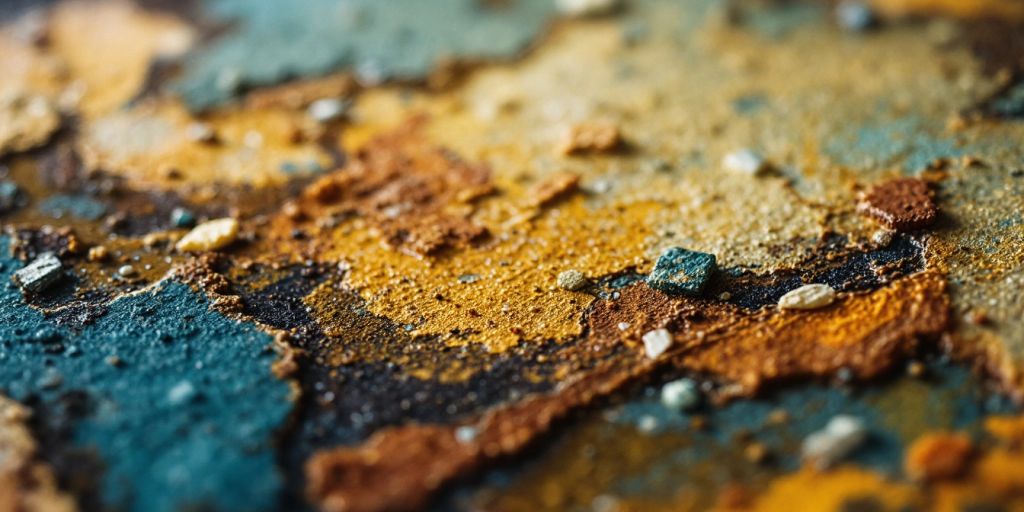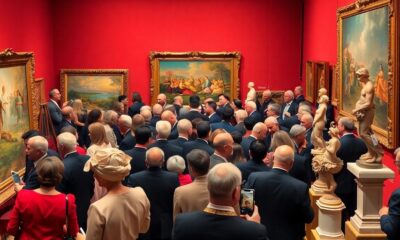Art & Culture
Art History Research: Uncovering the Past in Paintings

Art history research is essential for revealing the stories behind artworks and the cultures that created them. By examining paintings, we can uncover hidden layers of meaning and understand how art reflects societal values, beliefs, and practises. This article explores various aspects of art history research, from ancient cultures to modern technologies, highlighting the importance of context and ethical considerations in this field.
Key Takeaways
- Art history research helps us learn about ancient cultures and their social structures.
- Modern technologies like X-radiography and mass spectrometry reveal hidden details in artworks.
- Understanding the context of a piece of art is crucial for accurate interpretation.
- Ethical considerations are vital to balance research and preservation of cultural heritage.
- Museums play a key role in art history research by providing access to collections and engaging the public.
The Role of Art History Research in Understanding Ancient Cultures
Art history research plays a crucial role in revealing the complexities of ancient societies. By examining various forms of art, researchers can gain insights into the social structures and cultural practises of these civilizations.
Exploring Social Organisation Through Art
- Artworks often depict social hierarchies, showcasing the roles of different classes.
- Symbols and motifs can indicate the importance of certain groups or individuals.
- Artistic styles may reflect the values and beliefs of a society, revealing how they organised themselves.
Economic Systems Reflected in Art
- Art can illustrate trade practises, such as the materials used and their origins.
- The presence of luxury items in art suggests wealth distribution and economic power.
- Artistic commissions often reflect the economic status of patrons, indicating economic relationships.
Religious Beliefs and Artistic Expression
- Many ancient artworks are tied to religious practises, showcasing deities and rituals.
- The themes in art can reveal the spiritual beliefs and values of a culture.
- Artistic representations of myths often serve to communicate moral lessons or societal norms.
Languages and Art Forms
- Different art forms can represent the languages and communication methods of a culture.
- The use of symbols and inscriptions in art can provide insights into literacy and education.
- Artistic styles may evolve alongside language, reflecting changes in communication and expression.
Understanding ancient cultures through art is not just about the objects themselves; it’s about the stories they tell and the connections they reveal. Art serves as a bridge between the past and present, helping us comprehend the lives of those who came before us.
Modern Technologies in Art History Research
Mass Spectrometry in Art Analysis
Mass spectrometry is a powerful tool that helps researchers identify the chemical composition of pigments used in artworks. This technology allows for:
- Accurate identification of materials
- Understanding the artist’s techniques
- Insights into the artwork’s age and origin
Ultraviolet Fluorescence Photography
This technique reveals hidden details in paintings that are not visible to the naked eye. It can show:
- Areas of restoration
- Underlying sketches
- Changes made by the artist during the creation process
Infrared Reflectography
Infrared reflectography allows researchers to see beneath the surface layers of a painting. It is particularly useful for:
- Revealing underdrawings
- Understanding the artist’s working methods
- Identifying changes made during the painting process
X-Radiography in Art Conservation
X-radiography is used to examine the internal structure of paintings. This method can help in:
- Assessing the condition of the artwork
- Identifying previous repairs
- Understanding the layering of materials used by the artist
The integration of modern technologies in art history research is transforming our understanding of hidden layers in paintings. As we explore these advancements, we uncover new insights that reshape our appreciation of art.
In conclusion, the use of these modern technologies is essential for uncovering the secrets of artworks, allowing us to appreciate the rich history behind each piece.
Uncovering Hidden Layers in Paintings
Technical Imaging Techniques
In the world of art, hidden layers can tell us a lot about a painting’s history. Using advanced imaging techniques, researchers can look beneath the surface to discover what lies underneath. Some common methods include:
- Ultraviolet fluorescence photography: This technique helps identify materials used by the artist.
- Infrared reflectography: It reveals sketches and underdrawings that are not visible to the naked eye.
- X-radiography: This method shows the structure of the painting and any changes made by the artist.
Case Studies of German Expressionist Paintings
A recent study focused on German Expressionist paintings, where researchers uncovered exciting findings. They discovered:
- Complete underpaintings that were previously unknown.
- Lost titles that had been obscured over time.
- Studio graffiti that gives insight into the artist’s process.
Revealing Underpaintings and Lost Titles
The process of revealing these hidden elements is crucial for understanding the artist’s intentions. By examining the layers, researchers can piece together the story behind the artwork. This not only enhances our appreciation of the piece but also informs future conservation efforts.
Studio Practises of Famous Artists
Understanding how artists worked in their studios can change our view of their art. For instance, the materials they used and their techniques can provide context for their creations. This knowledge helps us appreciate the complexity of their work and the choices they made during the painting process.
The Intersection of Archaeology and Art History
Modern Archaeology Techniques
Modern archaeology plays a vital role in uncovering the past. It helps us discover ancient art and understand its significance. This connection between archaeology and art history is crucial for revealing our cultural heritage. Here are some key techniques used:
- Ground-penetrating radar: This non-invasive method allows archaeologists to see what lies beneath the surface without digging.
- 3D scanning: This technology helps create detailed models of artefacts, making it easier to study them.
- Dendrochronology: This technique uses tree rings to date wooden artefacts, providing insights into historical timelines.
Debates on Politics in Archaeology
The relationship between archaeology and politics is complex. Some argue that archaeology should remain neutral, while others believe it is influenced by political agendas. Here are some points to consider:
- Neutrality: Keeping archaeology unbiased can lead to more accurate findings.
- Political influence: Funding for projects may depend on political interests, affecting what gets researched.
- Cultural significance: Understanding the culture behind artefacts is essential, regardless of political views.
Cultural Insights from Artefacts
Artefacts provide a window into ancient cultures. They help us learn about:
- Social structures: How societies were organised.
- Economic systems: Trade and resource management.
- Religious beliefs: Insights into spiritual practises and rituals.
Preservation of Excavated Artefacts
Preserving artefacts is crucial for future generations. Here are some best practises:
- Proper excavation techniques: Minimising damage during digs.
- Storage conditions: Keeping artefacts in controlled environments to prevent deterioration.
- Public education: Engaging the community in understanding the importance of preservation.
The intersection of archaeology and art history not only enriches our understanding of the past but also shapes our cultural identity today.
In conclusion, the collaboration between archaeology and art history is essential for uncovering the stories of our ancestors. As we continue to explore, we must respect the cultural significance of the artefacts we discover, ensuring they are preserved for future generations to appreciate.
Proteomics and Its Impact on Art Conservation
Analysing Protein Composition in Paintings
Proteomics is a method that helps us understand the protein composition in artworks. By studying these proteins, we can learn about the materials used and how they have changed over time. This technique is especially useful for examining the ground layers of paintings, which can reveal much about the artist’s methods and the painting’s history.
Fermented Ground Layers in Danish Art
Recent studies have shown that some ground layers in Danish paintings contain proteins from fermented materials. This discovery is significant because it connects the art to the cultural practises of the time, such as beer brewing. The presence of these proteins indicates that artists may have used by-products from brewing in their work, which adds a new layer of understanding to the art.
Practical Studies on Ground Layer Mixtures
To explore how these proteins affect the ground layers, researchers conducted practical studies. They found that:
- Residual yeast acts as an emulsifier, helping to mix different components in the ground layer.
- This mixture creates a smoother surface for painting, making it easier for artists to work.
- Understanding these mixtures can help in the conservation of artworks by replicating the original conditions.
Future Applications of Proteomics
The future of proteomics in art conservation looks promising. As technology improves, we can analyse smaller samples with less damage to the artwork. This means we can:
- Study more museum objects without invasive methods.
- Understand how to slow down degradation of materials.
- Preserve artworks for future generations.
The destructive and invasive aspect of this research will soon not be an obstacle, allowing us to apply this technique to more museum objects.
In conclusion, proteomics is a valuable tool in art conservation, providing insights into the materials and techniques used by artists. By understanding these elements, we can better preserve our cultural heritage for the future.
Significant Discoveries in Art History Research

Identifying Models in Historical Paintings
Significant discoveries in art history have helped us uncover the past and understand the lives of people from different eras. Researchers have identified models in historical paintings that reveal much about the social structures and cultural practises of the time. For instance:
- Portraits of Nobility: Often depict the status and wealth of individuals.
- Everyday Life Scenes: Show common practises and attire of the period.
- Symbolic Elements: Include objects that represent power or spirituality.
Attributing Works to Famous Artists
Attribution studies have led to the identification of works by renowned artists, enhancing our appreciation of their contributions. This process involves:
- Technical Analysis: Examining brushwork and materials used.
- Historical Context: Understanding the artist’s life and influences.
- Comparative Studies: Looking at similar works to establish authenticity.
Uncovering Ancient Art Techniques
Recent findings have revealed ancient art techniques that were previously unknown. These discoveries include:
- Pigment Analysis: Identifying the materials used in paints.
- Layering Techniques: Understanding how artists built up their works.
- Tool Usage: Discovering the tools that were employed in the creation of art.
Impact of Discoveries on Art Market
The impact of these discoveries on the art market is profound. They can:
- Increase the value of artworks attributed to famous artists.
- Shift the focus of collectors towards newly discovered techniques.
- Influence the way museums curate their collections.
The exploration of art history not only enriches our understanding of the past but also shapes the future of art appreciation and conservation.
In summary, significant discoveries in art history research continue to provide invaluable insights into our cultural heritage, revealing the intricate connections between art, society, and history.
Conservation Science and Its Role in Art History
Methods of Conservation Science
Conservation science is essential for preserving artworks and understanding their history. Here are some key methods used in this field:
- Mass Spectrometry: This technique helps identify the materials used in artworks, revealing their composition.
- Infrared Reflectography: This method allows conservators to see under the surface layers of paintings, uncovering hidden details.
- X-Radiography: This technique is used to examine the structure of artworks, helping to assess their condition.
Challenges in Art Conservation
Conservators face several challenges, including:
- Material Degradation: Over time, artworks can deteriorate due to environmental factors.
- Invasive Techniques: Some analysis methods require taking samples, which can damage the artwork.
- Funding Limitations: Many conservation projects struggle to secure the necessary funding for research and restoration.
Case Studies in Conservation
Several notable case studies highlight the importance of conservation science:
- Danish Golden Age Paintings: Research on these artworks has revealed insights into their materials and techniques.
- Restoration of Ancient Textiles: Techniques used in textile conservation have improved our understanding of historical fabric production.
- Preservation of Mummies: Studies on mummies have provided valuable information about ancient cultures and their practises.
Conservation science plays a vital role in preserving our cultural heritage. By understanding the materials and techniques used in artworks, we can ensure their survival for future generations.
Future Directions in Conservation Science
Looking ahead, conservation science is expected to evolve with:
- Advancements in Technology: New tools will enhance our ability to analyse and preserve artworks.
- Interdisciplinary Collaboration: Working with scientists from various fields will lead to innovative conservation methods.
- Increased Public Awareness: Educating the public about the importance of conservation will help garner support for these efforts.
The Importance of Context in Art History Research
Understanding the context of art is crucial for grasping its true meaning and significance. Art does not exist in a vacuum; it reflects the culture, beliefs, and practises of its time.
Cultural Context of Art Materials
- Different cultures use various materials based on availability and tradition.
- The choice of materials can indicate the technological advancements of a society.
- For example, ancient Egyptians used specific pigments that were significant in their religious practises.
Historical Significance of Art Techniques
- Techniques evolve over time, influenced by cultural exchanges.
- The use of perspective in Renaissance art marked a shift in how space was represented.
- Understanding these techniques helps us appreciate the innovation of artists.
Interdisciplinary Approaches to Art Research
- Collaboration between historians, archaeologists, and scientists enriches art research.
- Techniques from other fields, like chemistry, can reveal hidden layers in paintings.
- This holistic approach provides a more comprehensive understanding of art.
Impact of Societal Changes on Art
- Art often reflects societal changes, such as political movements or technological advancements.
- For instance, the rise of modernism in the 20th century mirrored rapid industrialisation.
- Artists respond to their environment, making their work a commentary on contemporary issues.
The study of art is not just about aesthetics; it is a window into the lives and thoughts of people from different eras. Understanding the context allows us to appreciate the depth and richness of artistic expression.
The Ethical Considerations in Art History Research

Balancing Preservation and Research
In the field of art history, balancing preservation and research is crucial. Researchers must ensure that their work does not harm the very artefacts they study. Here are some key points to consider:
- Respect for the original work: Any analysis should aim to maintain the integrity of the artwork.
- Non-invasive techniques: Using methods that do not damage the art is essential.
- Collaboration with conservators: Working alongside conservation experts can help protect the artwork.
Respecting Cultural Heritage
Art history research often involves artefacts from diverse cultures. It is vital to:
- Acknowledge the origins: Understanding where the art comes from helps in respecting its significance.
- Engage with local communities: Involving those connected to the art can provide deeper insights.
- Avoid appropriation: Researchers should be careful not to exploit cultural symbols or practises.
Challenges in Ethical Research
Conducting ethical research in art history can be complex. Some challenges include:
- Access to artefacts: Gaining permission to study certain pieces can be difficult.
- Funding influences: Research may be swayed by the interests of those providing financial support.
- Cultural sensitivities: Some artefacts may hold spiritual significance, complicating their study.
Understanding the ethical dimensions of art history research is essential for fostering respect and integrity in the field.
By addressing these ethical considerations, researchers can contribute positively to the understanding and appreciation of art while safeguarding its cultural significance.
Case Studies in Ethical Dilemmas
Several case studies highlight ethical dilemmas in art history:
- The Elgin Marbles: The debate over their rightful ownership continues to spark discussions on cultural heritage.
- Looted Artefacts: Many museums house items taken during conflicts, raising questions about their legitimacy.
- Restoration Practises: Decisions on how much to restore an artwork can lead to ethical conflicts regarding authenticity.
The Evolution of Art History Research Methods
Art history research has changed a lot over the years. New methods and technologies have made it easier to study and understand art from different times and places. Here are some key areas of evolution:
Traditional Methods in Art Research
- Visual Analysis: Looking closely at the artwork to understand its style and technique.
- Historical Context: Researching the time period and culture in which the art was created.
- Artist Studies: Learning about the lives of artists to gain insight into their work.
Advancements in Research Technologies
- Digital Imaging: Using high-resolution images to see details not visible to the naked eye.
- Chemical Analysis: Testing materials in artworks to learn about their composition.
- 3D Scanning: Creating three-dimensional models of artworks for detailed study.
Interdisciplinary Collaborations
- Working with Scientists: Art historians now often team up with scientists to use advanced techniques.
- Cultural Studies: Collaborating with anthropologists to understand the cultural significance of art.
- Technology Experts: Partnering with tech specialists to develop new tools for research.
Future Trends in Art History Research
- Increased Use of AI: Artificial intelligence may help in analysing patterns in art.
- Global Perspectives: Focusing on art from diverse cultures around the world.
- Public Engagement: Involving the public in research through crowdsourcing and community projects.
The evolution of art history research methods shows how important it is to adapt to new ideas and technologies. This helps us uncover more about our past and appreciate art in new ways.
In summary, the evolution of art history research methods reflects a growing understanding of the importance of combining traditional approaches with modern technology and interdisciplinary collaboration. This evolution not only enhances our knowledge but also enriches our appreciation of art across cultures and time periods.
The Role of Museums in Art History Research
Museums play a crucial part in the study of art history, acting as guardians of culture and history. They not only preserve artworks but also provide a space for research and education. Here are some key aspects of their role:
Exhibitions and Public Engagement
- Museums host exhibitions that showcase various art movements and historical periods.
- They engage the public through workshops, lectures, and guided tours.
- Special events often highlight the importance of art in society.
Museum Collections and Research
- Collections serve as primary resources for researchers studying art history.
- Museums often collaborate with universities and scholars to conduct in-depth research.
- They provide access to rare artefacts that might not be available elsewhere.
Collaborations with Researchers
- Museums partner with researchers to explore new findings in art history.
- These collaborations can lead to significant discoveries about artists and their techniques.
- Joint projects often result in publications that contribute to the field.
Museums are not just places to view art; they are vital for understanding our past and shaping our future.
In conclusion, the role of museums in art history research is multifaceted, encompassing preservation, education, and collaboration. They are essential for uncovering the stories behind artworks and connecting us to our cultural heritage. The history of museums shows us that the evolution of public spaces and private spaces come together to create more than just a place to reflect.
Conclusion
In summary, the journey through art history reveals much more than just beautiful images. Each painting tells a story, hiding layers of meaning and techniques that can be uncovered through careful research. As we explore these hidden aspects, we gain a better understanding of the artists and the times they lived in. This ongoing quest not only enriches our appreciation of art but also connects us to our shared human experience. By continuing to investigate and learn from these masterpieces, we ensure that the lessons of the past remain alive for future generations.
Frequently Asked Questions
What is the importance of art history research?
Art history research helps us understand how past cultures lived, what they believed in, and how they expressed themselves through art.
How do modern technologies aid in art history research?
Modern tools like X-rays and infrared photography allow researchers to see beneath the surface of paintings and discover hidden details.
What can we learn from hidden layers in paintings?
Hidden layers can reveal the artist’s original ideas, changes they made, and even the materials they used.
How does archaeology relate to art history?
Archaeology helps uncover artefacts that provide insights into ancient cultures, which can enhance our understanding of their art.
What is proteomics and why is it important in art conservation?
Proteomics studies proteins in artworks, helping conservators understand how to preserve and restore them.
What are some significant discoveries in art history?
Discoveries include identifying unknown artists, revealing ancient techniques, and understanding the context of artworks.
How do museums contribute to art history research?
Museums collect, preserve, and display art, while also engaging in research and educational programmes.
What ethical issues arise in art history research?
Researchers must balance the need for discovery with respect for cultural heritage and the preservation of artefacts.
-

 Business6 days ago
Business6 days agoS&P 500 Soars in Best May in Decades Amid Tariff Relief and Nvidia’s Surge
-

 Immigration6 days ago
Immigration6 days agoTrump’s Immigration Crackdown: Legal Battles and Policy Shifts
-

 Business6 days ago
Business6 days agoUS Stock Market Soars in May Amidst Tariff Tensions and Inflation Worries
-

 Government6 days ago
Government6 days agoTrump Administration’s Government Reshaping Efforts Face Criticism and Legal Battles
-

 Business6 days ago
Business6 days agoTrump’s Tariffs: A Global Economic Reckoning
-

 Foreign Policy4 days ago
Foreign Policy4 days agoInside Schedule F: Will Trump’s Federal Workforce Shake-Up Undermine Democracy?
-

 Press Release3 days ago
Press Release3 days agoIn2space Launches Campaign to Make Space Travel Accessible for All













